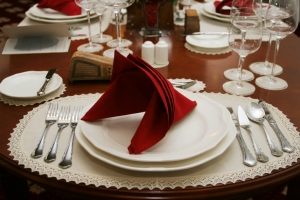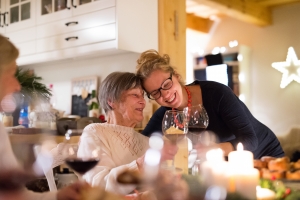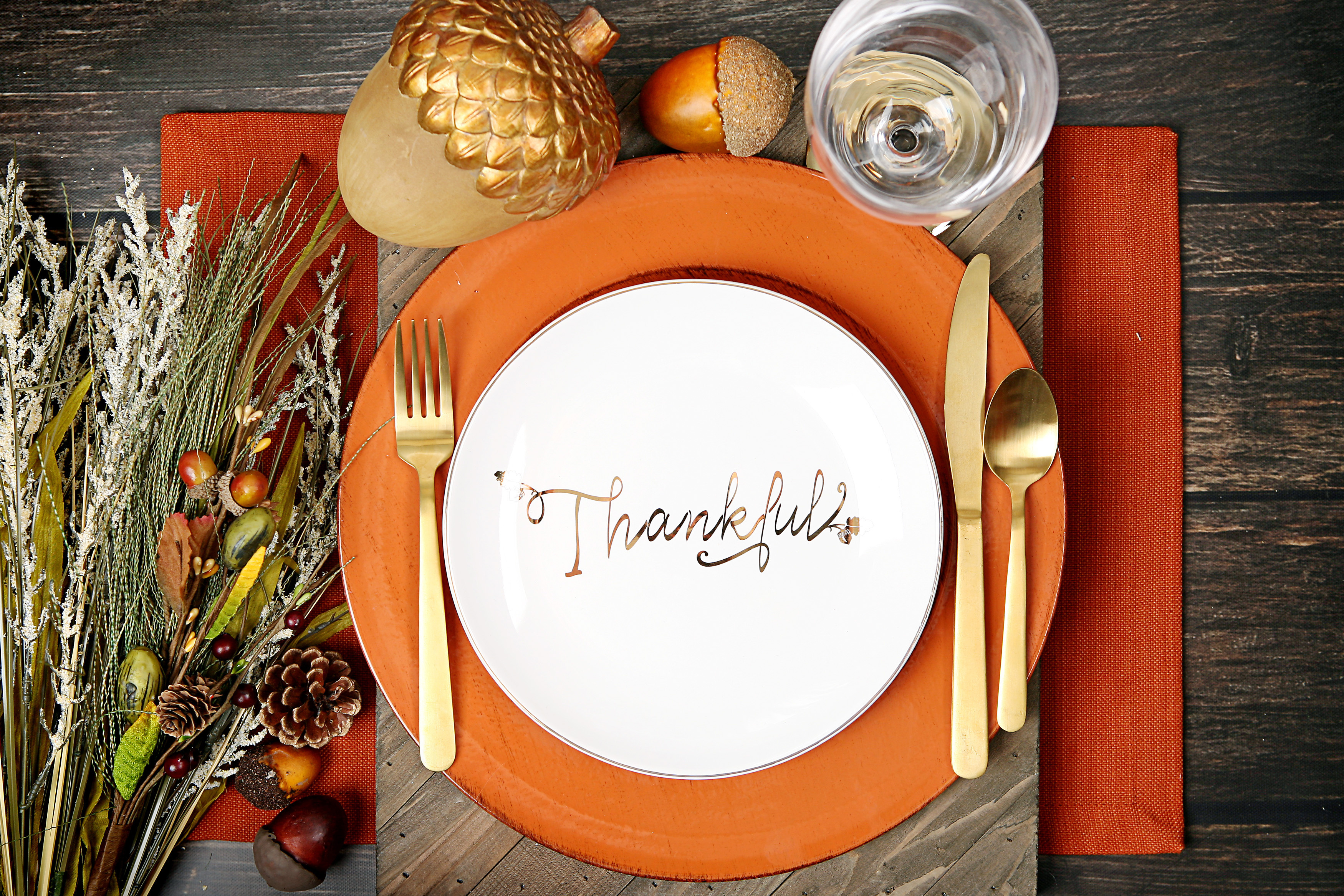Thanksgiving dinner, one of the most important family celebrations in the United States. As in any other family dinner, it is crucial to take into account a number of etiquette tips in order to ensure everyone has a pleasant evening.
Punctuality
Make an effort to arrive to the event on time. It is not only out of courtesy for the host, hostess and rest of the guests but also the food might not be in good condition if not served at the scheduled time. When we arrive late we might make other guests upset because of a lack of consideration and this is a very bad way to start the night and make a positive impression.
Host-Hostess gift
You should always bring something. You can ask the host what you can bring (Something we always do in my family, the host will tell each person what to bring) If the host tells you to not bring anything you can still bring something not related to food or the typical wine, which will show appreciation. There are several simple ideas; for example a candle, a bathroom soap, even a card personalized by you giving thanks shows that you are thankful for the invitation.
Positive attitude
Go to the dinner with a positive attitude. Don’t be negative and don’t criticize neither yourself or others. Having a negative attitude really creates a bad energy for everyone. It is crucial that we learn to leave our issues at the door, and do our best to come in with a smile and ready to enjoy. There is nothing more refreshing than spending an evening with an optimistic person.
Dress code
No matter the setting where your thanksgiving dinner will be, either at home, or a someone’s house, you can still look put together. The key is to dress for the occasion, the setting and to look in tune with the rest of the guests. If you’re lounging at home you can wear something more cozy and casual but still stylish or if you want to impress at a more formal gathering, you can wear something more classic like a dress. Remember no matter what you are wearing, your attitude and the way you present yourself is really what is going to make you stand out.
Seating arrangements
Let me start by saying that your biggest goal as a host is to make sure you and everyone is happy and feels at ease, after spending a couple of years studying protocol at the Escuela Internacional de Protocolo in Spain, I can give you all the bells and whistles of seating protocol. Truth is, there are hosts which really enjoy the process of seating arrangements, and there are others who don’t enjoy the whole “Seating chart and place card process”. In events like these, there are benefits to assigning seats to our guests. Think about what happens when we don’t have any seating arrangements, people will tend to stick to those who they know best and are less likely to socialize, also when it is time to sit during dinner time it might get a little chaotic. When you assign their seats, you are giving them an opportunity to have conversations that they might not have had otherwise or get to know different people at a deeper level, which could in turn make their night exciting and unforgettable.
As a host, if we are in fact going to do seating arrangements it is important to take these tips into consideration:
First thing we want to do is check if we have a big enough table and chairs for the number of guests we are having. We usually sit children either at another table for practical reasons or if seating in the same table as the adults, sit them next to their parents. Be aware that sitting kids at a different table can bring issues, they are kids! so I do recommend that they have an adult supervising and checking on them in case they need anything or there are any problems. Also consider sitting children according to their age, if you have a group of teens, you don’t want to sit one of the teenagers with a group of preschoolers.
Traditionally, the host and hostess sit at either end of the dining table, then we arrange our guests according to their age or if they are honored guests; for example, grandparents or a guest of honor. In this case, you sit this person to the host’s or hostess right, following their left. In the case of having more than one table, an option sometimes used, is the host and hostess sitting at different tables, the benefit of doing this is that they can both make sure the guests at both of these tables are being taken care of and in the case of more tables, they can ask a close friend for assistance if someone needs anything. When seating the rest of the guests, I encourage you to take into account:
- Mixing genders, ages and interests is fantastic for initiating interesting conversations. On the other hand, if you have two guests who enjoy the same interest, sitting them together will also start an amazing conversation!
- Take into consideration your guests’ overall personality. If you have a guest who is a joker or extrovert you could sit him or her towards the center of the table. Sitting the extrovert next to the introvert might encourage a conversation that might not otherwise happen if we sit two introverts together. Lastly, never sit two people together who tend to have extreme views, or that very inappropriate friend with your easy to upset and impatient uncle.
- Do you have any guests who don’t get along? A little obvious but please don’t sit them together!
- Another tricky topic is how to sit couples. If we follow traditional event protocol, we usually sit them separately so we encourage them to socialize. If they are married, try to keep them at a close distance. If they have kids and you are sitting the kids at the table, you can sit the couple together, or at least make sure the kids are sitting next to mom or dad. Also, going back to your guests’ personalities, take into consideration who you sit very close to a baby or toddler, we all know that guest who will be more likely to get angry over a child possibly throwing food on their outfit.
Our goal is to make sure everyone has an enjoyable meal, always ask yourself: “Will this person feel happy and comfortable sitting next to this person?” Also, if needed make proper introductions between guests who will be sitting together but do not know each other.
Serving the food
When serving the food you could follow the same ranking order as you did when you arranged where the guests would sit; in this case you could start with the “Guest of honor” which would be seated to the host’s right, or you could start with the oldest person, remember the host or hostess is always last. If you are having someone serve the food, the server will serve the food counterclockwise, the host will be served last and we present the food on the guests’ left and remove it from their right.
At a more casual gathering, we can offer the guests a buffet, in this case they serve themselves. If serving directly from the dining table, the host or hostess may pass the food to his/her right (counterclockwise), again with the host/hostess served last.
At sit down dinners in which food is being served, no one should start eating until everyone has food on their plate or the host has advised them to start. A setting in which everyone is serving themselves can take a bit more time so in this case, the host or hostess may advise the guests to start eating after about 4 people have served themselves.
Passing the food
When passing the bread, you should take the piece of bread with your hand and place it on the bread plate; when passing salad in a big bowl, pass it to you right and hold the bowl for the next person to make easier for him or her to grab their salad portion; lastly if you are passing the salt and pepper or you are offering different sauces, make sure they are passed together (for sauces you could use a dish with divided sections). One thing to remember is to never reach for anything while putting your arm on top of another person’s plate; if you can not reach what you need, you must ask the closest person to the item you need to please pass it. Also, neither food or silverware should be shared.
Dining
Dining etiquette is easier than you think, although if we don’t take the time to learn it, it will backfire especially in situations in which we have to gather at a table to eat. Nobody wants to be remembered as the guest who had terrible dining manners. Although covering all the aspects in dining etiquette would cover more than one post, I will give you a few tips to make sure you not only feel at ease but you project self-confidence and poise.
1. Napkin: should be placed on your lap when you sit down to eat, if you must excuse yourself from the table but you are not done eating, place your napkin on the chair. If you are done eating, place your napkin to the left of your plate.
2. Cutlery: First thing first, hands are used on very few occasions, when eating we should use the silverware to grab the food almost always. Each utensil has a purpose and if placed on the table it is because you are expected to use it, technically there are more than 30 different utensils and each one has a different shape, size and is used for a specific purpose. If you are not sure about a specific utensil, you could watch the rest of the people and how they use it, or confidently ask the person closest to you what that utensil is for. I will give you one tip that will really help with the silverware: always work from the outside in as you eat your different courses, starting with the silverware that is farthest from the plate.
For this post, I will give you a few tips on how to properly use the utensils.
- Utensils remain on the table until we are ready to eat.
- Once we start using the silverware, it never goes back on the table or linen.
- Silverware is only used for eating, we do not use it to gesticulate or point to somebody. If you want to use your hands while talking, put your utensils down in resting position on the plate and then use your hands.
- If you drop food or a utensil, never put it back on the table, in the case of dropping food on the floor never clean it with a napkin or any type of fabric; if you’re in a restaurant and you drooped a utensil, let the server know and leave it there unless it is dangerous for other people, in this case pick it up and let the server know. If you drop your napkin you may pick it up and put it back on your lap, never put a fallen napkin on your plate.
- If you must pass a utensil to another person, never pass it with the blade facing the person, always pass it with the handle facing the person. Never touch the blade or any section that comes in contact with the food.
- Utensils don’t have a special language, but there are guidelines to signal if you are just resting them or done with your food, and the way we do this really depends if we are using the American Style of dining or the Continental Style of dining. Let me give you a little overview of these two styles (I hope this helps as this is best taught in person)
- The American Style of dining is the one mostly used in the United States. We cut with the knife in the right hand, then we rest the knife on the plate (blades facing in), we switch the utensils and grab the fork with our right hand. To rest the utensils, put your knife on the top right of your plate and your fork in the middle with tines facing up. When you are done eating put the fork with tines facing up in the middle of the plate with the knife parallel to it, blades facing the fork.
- The Continental Style is commonly used outside of the United States, it is a bit different than the American Style because in this style you do not switch the utensils, you always hold the knife with your right hand and the fork with your left, you never switch or put them down unless you put them in resting position or you are done eating. You hold the food with your fork, cut the piece of food with the knife, and bring the piece of food to your mouth keeping both utensils in the same hand. Resting position is crossing the utensils on your plate, place the fork blades down and on top of the knife (Imagine an X on your plate). When you are done eating you will place the utensils parallel to each other like in the American Style but the with fork tines facing down.
- Never use your own utensils to serve yourself sauce or anything else, you should use the utensil provided by the host or hostess for that specific item.
- Food always goes to your mouth, never your mouth to the food, you want to maintain a straight position but lean a little when eating.

Conversation
What would I advice you to stay away from? Any conversation that might be uncomfortable, emotionally painful or unpleasant, past discussions or issues, diseases, accidents or anything too graphic while people are eating. Politics can be dangerous if we have guests that are in opposite points of view (Do we really want to eat while a Democrat and Republican go at it?) Religion can also be a touchy subject for some people, specially if others say inappropriate or offensive comments to their religion. Don’t criticize or talk negatively about anything or about others.
What to talk about? Compliment someone, ask questions about hobbies or interests, ask for an advice, ask about a vacation or experience, “Peter, I heard you went on vacation to Colorado, that sounds amazing! What did you like the most about your trip?”, discuss music, history; a topic we discuss a lot in my family are memories, we love talking about funny or beautiful memories. Remember to have a positive and cheerful attitude. Lastly, don’t forget to talk about what you are grateful for!
Other important tips?
Don’t bring surprise guests, ask the host or hostess in advance so they can make the necessary food and drink arrangements and you can ask what you can bring. Put your cell phone away while eating and also during the party, you will have time to use it later, but for now enjoy the time and make an effort to talk and socialize. Offer help with the cleanup, especially in a celebration like this which is usually done in a friend’s or family’s house. Don’t be the guest who stays forever! Look for cues from the host or hostess and leave at an appropriate time. Lastly, give thanks for the invitation and even better, after the dinner call or send a note to give thanks for the wonderful time and the delicious food.
Last words, remember what it’s all about
We must remember what Thanksgiving all is about: sharing good wishes with the people we love. It is a celebration in which people who are usually separated either by distance or daily responsibilities, gather to sit down for a special dinner. This special dinner is about giving thanks for all the good in our lives and share blessings with others around us.


